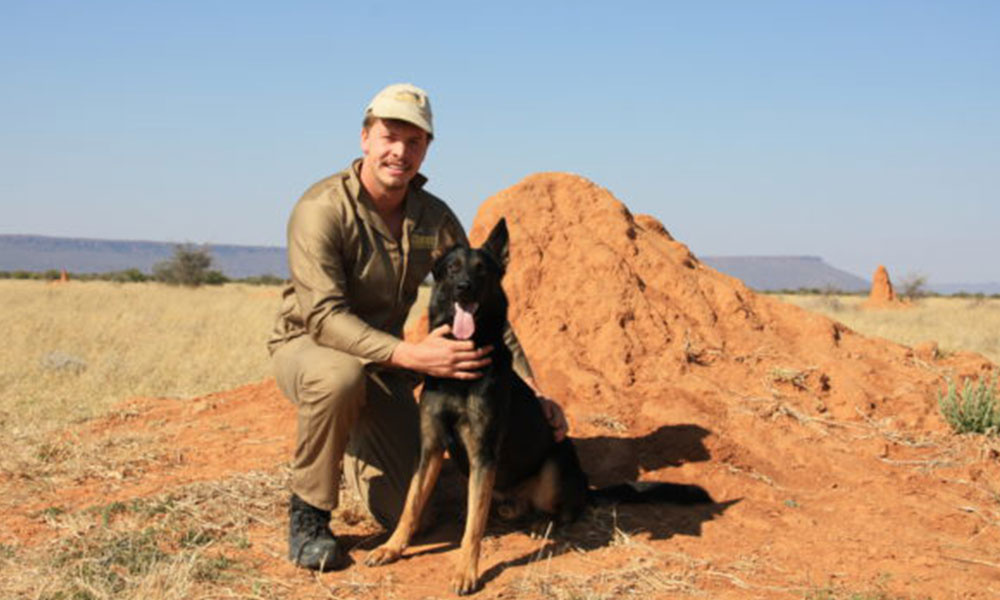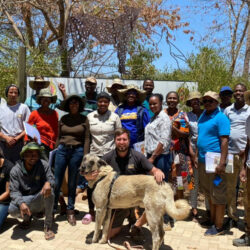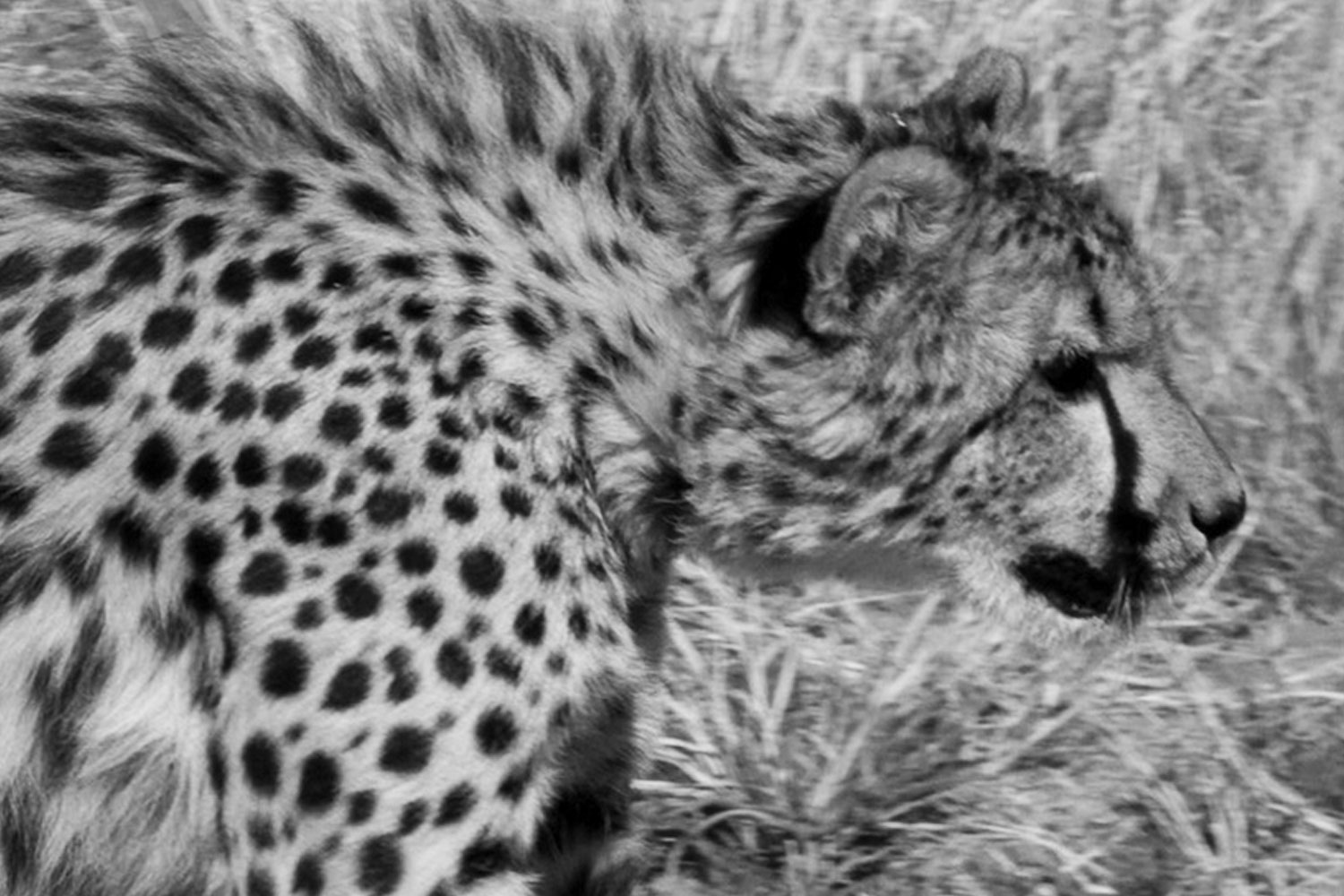Dog Dream Job: Scat Detection in Cheetah Conservation
-

- by Meredith Hanel July 12, 2019

“Ewww, leave it!”
Dogs love sniffing stinky things and most dog owners don’t reward their dogs for finding poop from other animals. Dog handlers at Cheetah Conservation Fund (CCF) do just that. Scat detection, from cheetahs and other animals in their habitat, is one of two job types for dogs at Cheetah Conservation Fund (CCF), the other being guarding livestock. Both jobs are vital in cheetah conservation efforts.
Conservation detection dogs have been used since the 1890s, and initially focused on detection of live birds like the New Zealand kiwi. In addition to live wildlife, these working dogs detect carcasses of birds and bats around wind turbines, pathogens, animal dens, urine and scat. A scat detection dog has even been used to find orca poop a nautical mile away. When combined with modern genetic analysis, scat detection has become a valuable tool in conservation.
CCF uses dogs to find cheetah scat so that they can track where cheetahs go, what they eat and even what foods they are losing to other predators that they compete with. Genetic analysis of cheetah scat is a non-invasive method of obtaining information about individual cheetahs in the wild and about the cheetah population like overall numbers, demographics, sex ratios and kinship. The gathered data helps CCF make informed decisions about how to prioritize the preservation of cheetah habitat and where best to reintroduce previously injured or orphaned cheetahs back into the wild. Human wildlife conflict is a major obstacle in protecting cheetahs. Analysis of cheetah scat can show farmers that cheetahs are not preying on their livestock, which saves cheetahs from being trapped or killed.
To identify which animal the collected scat comes from, scientists perform DNA analysis. To identify what the animal ate involves cleaning the scat. Scientists can be surprisingly inventive when it comes to using easily available materials in their protocols. In one protocol, scat is placed inside nylon stockings and washed in a washing machine with no soap, leaving behind bones, hair and vegetation. Prey can be identified by looking at the hair and bones with the naked eye and microscopic analysis of burned hair. CCF uses a technique where hair is placed on a plastic cover slip, placed between two glass slides and heated in a toaster oven to reveal an identifiable imprint pattern of the hair.
We all know dogs have a great sense of smell and love to smell stinky things but there is a lot of training that goes into developing a scat detection dog. Not only do they need to have a strong drive to find certain types of scat among a variety of interesting smells, they need to clearly let the handler know when they have found it. In one training scenario, dogs are presented with 4 pipes with a ball or toy that they like hidden inside with cheetah scat. After a few trials, the toy is removed and given as a reward after the cheetah scat scent is detected.
Levi at CCF Namibia
CCF’s first scat detection dog was Finn, a rescued border collie who came in 2009, trained by Chris Bartos, assistant curator of Franklin Park Zoo in Boston. In a training exercise Finn was able to find 72 out of 86 hidden scat samples. In 2017, Levi, a Belgian Malinois/German Shephard cross joined the team with a previous job history in detection of rhino horns to prevent poaching. For CCF Levi has been trained to detect the scat of cheetah, leopard and African wild dogs.
The role of scat detection dogs is significant in making it possible for CCF to monitor cheetahs, which are secretive in nature. To a dog the job of finding animal poop would seem perfect. Just don’t tell them how much they are helping cats.
References
News from CCF’s Scat Dog Program. (2017) Global Giving – Cheetah Conservation Fund Staff.
Tiger the CCF Cheetah Scat Dog. Ortho Pets.
Tucker, the Orca Poop-Detection Dog in SeattleMet. (2017) Department of Biology, University of Washington News.
What We Do. Cheetah Conservation Fund.
Beebe, S.C., Howell, T.J. and Bennett, P.C. Using Scent Detection Dogs in Conservation Setting: A Review of Scientific Literature Regarding Their Selection. (2016) Frontiers in Veterinary Science.
Curry, Caitlin. Utilization of Conservation Dogs at the Cheetah Conservation Fund. My Life is Crap.
Groc, Isabelle. These dogs live to work – and threatened animals live because they do. (2017) Ensia.
Hofmann, Tim. CCF’s Next Generation of Detection Dogs. (2018) Cheetah Conservation Fund.
Marker, Laurie. Cheetah Conservation Fund 2017 Annual Progress Report. (2017)
Walsh, Alicia. Diet Analysis for Wildlife Management: Protecting the Cheetah in Namibia (2015). University of New Hampshire, Inquiry Journal.
Related Reading
-
November 9, 2023
Giving Tuesday Canada 2023 – Supporting Namibian Youth



